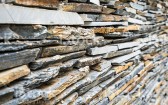Our Products
Schist Stone
Schist is a globally unique rock source combined with versatility, practicality, sustainability, durability & extreme good looks. Choosing a variation of tones can produce an attractive finish and blend seamlessly into the landscape.
FAQ's
Frequently Asked Questions
What is Schist Rock?
Schist is a crystalline rock that has a highly developed schistosity, or tendency to split into layers. Most schists are composed largely of platy minerals such as muscovite, chlorite, talc, sericite, biotite, and graphite. The mineralogy and high water content of the minerals indicate that they were formed under conditions of low temperature and high pressure.
How do I choose my stone?
There are many style options, making choosing your schist an exciting task. We are here to help you to narrow down what you need.
When should I order my stone?
It is best to order the schist early in your build process to avoid waiting, especially in the spring and summer. We try to keep stock of our most popular products so call to see what is available.
Can I place increment orders for a project done in stages?
We can supply in increments; however, we may not be able to colour match perfectly. It is advisable to order all your stone at the same time, even if you will complete the job in stages.
How do I define the Stacking style?
Stacking style is determined by the amount of grout that remains visible. The stacking style has a dramatic effect on the finished appearance of the stone, it can completely change its character. Narrow joints can complement the look of the stone and provide a solid appearance, while wider gaps can emphasise the individual stone elements. A dry stacked wall, for example, is built using only stone, gravel & backfill material. No mortar or cement.
Employment
Employment
Loader Operator/Customer Service
About the Role
We are seeking a Loader operator/Customer service person to join our team. The position is based in Frankton, Queenstown for an immediate start. It is a customer focused role loading trucks and maintaining our Frankton depot, with a Monday to Friday roster 7am to 5:30pm. Customer Service and machine operating experience essential.
What RSNZ can do for you
- You will be rewarded with a competitive salary package
- Possibility of short-term accommodation in Frankton to help you with relocation (conditions apply)
- Company Health Insurance (conditions apply)
- Well maintained equipment
- Permanent full-time work
- Possibility of flexible work hours
What RSNZ require from you
- Are you safety conscious and confident to contribute to a positive safety culture, ensuring procedures are followed and documented?
- Do you always strive to improve the production process and the quality of materials produced?
- Are you looking for a hands-on role and possess a positive approach?
- Have you had exposure to health and safety and risk management systems?
- Do you understand quarry product specifications?
- Do you have experience in customer sales and product requirements?
- Do you have the ability to understand anticipated future product requirements and plan accordingly?
- Do you like to maintain a tidy and organised work environment?
- Do you have personal drive and the ability to work autonomously?
- Do you have good written and verbal communication?
If you answered Yes to majority of these questions, then we think you will fit right into our team environment and our RSNZ culture – give us a call today to discuss!
Please forward your resume to: admin@rocksupplies.nz or call 027 430 1672






